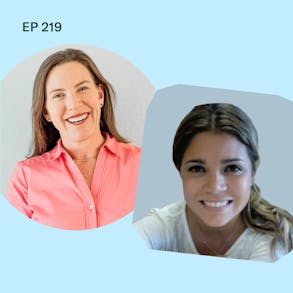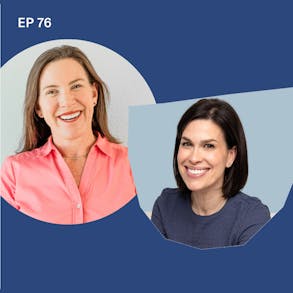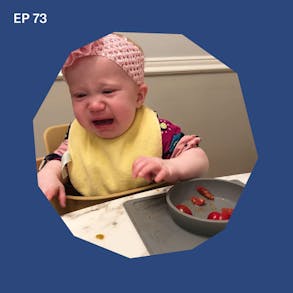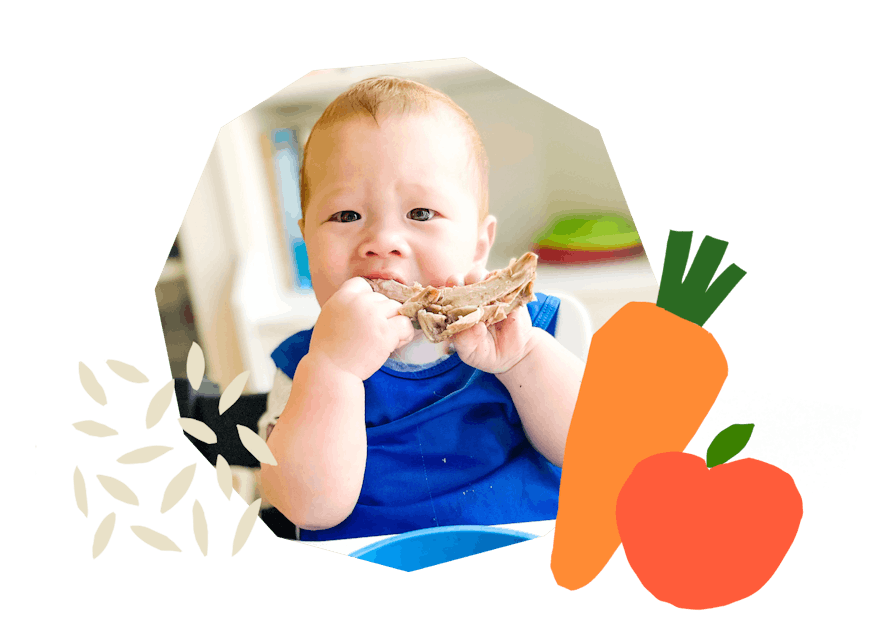How to Sous Vide Meat Safely for BLW with Iliana Cruz
- The sous vide method of cooking and how this can be a safe option for cooking and offering meats to babies
- The different cuts of meat that do best in sous vide cooking and also end up with a consistency that is soft for baby-led weaning
- Iliana's personal experience with their youngest baby who is currently doing baby-led weaning and eating meats that are cooked with the sous vide method

LISTEN TO THIS EPISODE
Episode Description
Ever wonder what other ways you can use to cook meat for your baby during baby-led weaning? In this episode Iliana Cruz, an owner of a meat processing plant specializing in the sous vide cooking method is here to describe how using this method of cooking can help prepare meat with perfect texture and consistency for BLW.
About the Guest
- Iliana Cruz and her husband are owners of a meat processing plant in Columbus, Ohio called Hudson Meat Company which specializes in cooking meat using the sous vide method
- They are parents to 5 children and had never done baby-led weaning until their last baby Adrian who is now 8 months old
- Their company cooks meat for food service, cutting time by half in restaurants, cruise ships and the Army

Links from this Episode
- Baby-Led Weaning with Katie Ferraro program with the 100 First Foods™ Daily Meal Plan, join here: https://babyledweaning.co/program
- Baby-Led Weaning for Beginners free online workshop with 100 First Foods™ list to all attendees, register here: https://babyledweaning.co/baby-led-weaning-for-beginners
Other Episodes Related to This Topic
- Ep 178 “White Meat Your Baby Can Safely Eat”
- Ep 177 “Red Meat Your Baby Can Safely Eat”
- Ep 176 “BLW at the Butcher: Identifying Ideal Cuts of Meat for Babies with 4th Generation Butcher Cara Nicoletti”
- Ep 175 “Pork: How to Safely Prepare Pork for Baby-Led Weaning”
- Ep 117 “Game Meat: How to Offer Game Meats Safely to Your Baby”
- Ep 76 “Sustainable Meat: Smart Selections for Starting Solids with Diana Rodgers, RD”
- Ep 19 “Meat: How to Prepare Meat Safely for Baby-Led Weaning”

Latest Episodes






Iliana Cruz (1s):
Sous vide is perfect for baby-led weaning for several reasons. Number one, it's the meat is seasoned. The meat comes out soft. You can shred it in your hands and then put it on the plate and the baby just grabs it.
Katie Ferraro (14s):
Hey there I'm Katie Ferraro Registered Dietitian college nutrition professor and mom of seven specializing in baby led weaning here on the Baby-Led Weaning Made Easy Podcast. I help you strip out all of the noise and nonsense about feeding, leaving you with the competence and knowledge you need to give your baby a safe start to solid foods using baby-led weaning. Well, hello there and welcome back. This is a little bit of a different type of episode today. It's going to be an interview. Normally my Monday episodes are mini baby-led weaning trainings, and I do them solo and I've been wanting to talk about using the sous vide method to make meat safe for baby-led weaning.
Katie Ferraro (58s):
And if you've never heard of sous vide or you're like sous what, it's just basically a method of cooking food, especially meat or fish, where you vacuum seal and immerse it in warm water. And I had heard it was like a fancy thing if you didn't feel like in the foodie world a while ago. And then my husband was not fancy, came home from the store with a sous vide machine. And I was like, oh, great, another like overpriced expensive kitchen thing that like, we're never going to use and then he showed me how to use it. And normally he makes the meat in our family not to like gender stereotype, but I really just don't like making meat he's from Texas and it's the only food he likes to make, but he taught me how to use it, and I was like, wait a minute, I love this machine thing because you can't overdo the meat.
Katie Ferraro (1m 38s):
Like that's my problem. Like cooking one thing and not paying attention. And then it gets really tough. And you know, for babies, you cannot serve them tough meat. So we were thinking about doing a sous vide episode and I don't know, it just wasn't priority. Then Iliana Cruz emailed me and she's like, okay, I'm doing baby led weaning with my baby. She has her son, Adrian, this is her youngest. She has five children and her and her husband, Iliana and her husband work for her husband's company. I mean, I assume like her husband works for her, that's how it works in most families, just kidding, but the Hudson Meat Company, she's like my husband's company, the Hudson meat company, we make sous vide meat that we sell to like the army and restaurants and other like, you know, outlets like that and I just realized as I'm doing baby-led weaning, and I'm in some of your courses with Adrian, like sous vide is the perfect texture consistency for me, for baby-led weaning.
Katie Ferraro (2m 22s):
So her son, Adrian is eight months of age. I'm like, dude, he's the luckiest baby in the world. Cause you've got all this sous vide meat laying around. It's like perfect texture to feed the babies. So rather than me talking about sous vide, Ilianna emailed me to ask like how we might be able to incorporate the Hudson Meat Company into some of our physical product stuff that we're working on. And I was like, oh, why don't you come on the podcast and talk about what sous vide is? So Iliana Cruz is a mom of five, she is married to her husband. He's the Hudson Meat Company guy and she's going to talk a little bit about the work they do. You can tell from the conversation that they work together on it. So she's going to share a little bit about sous vide about what it is not so much about what their company does because you can't even buy. It's like not direct to consumer, but I just don't want you guys to rule out sous vide as a really, really easy way to make meat safe for baby-led weaning.
Katie Ferraro (3m 10s):
So with no further ado here is Iliana Cruz of the Hudson Meat Company talking about how to sous vide meat safely for baby-led weaning.
Iliana Cruz (3m 22s):
Hi Katie.
Katie Ferraro (3m 23s):
Okay. I have to tell you guys just send me an email asking me about something totally unrelated. And I was like, can you please be on the podcast? Because she told me what her family does. And she's going to tell you guys in a second, but Eliana, before we get started, like maybe just give us some background. What is the family's business? How did you come to specialize in this like unique food preparation method?
Iliana Cruz (3m 40s):
Okay. So we have a meat company in Columbus, Ohio. My husband stepped up, started it around 1978 and he had a French sales man back in the day to help them distribute the meat. And he told my husband's step-dad why don't you sous vide cook your meat. And it started from there.
Katie Ferraro (4m 1s):
What year was this?
Iliana Cruz (4m 2s):
1978
Katie Ferraro (4m 3s):
That they started to Sue
Iliana Cruz (4m 5s):
To sous vide. I don't know how they cooked it before, all I known was that after this French salesman came, told him how to do it. And they bought this machine that has big kettles, bag and they put the meat in a bag, submerge it in the hot water and cook it for long periods of time. And the results have been nothing but incredible, soft, delicious meat ever since for 30 years. So we specialize in custom cooking. So a customer calls us and say, I want this seasoning. I want this temperature on the meat. And my husband says, okay, bring it on. He either buys the meat or he receives the meat in the plant, cooks it, bags it And off it goes
Katie Ferraro (4m 47s):
So in preparation for this episode, I was reading a little bit about the history of sous vide. So apparently it started making its way into the restaurant scene, kind of in the mid seventies, like 1974 is what it looks like. But I know in the United States it only became popular in the early two thousands. When like celebrity chefs would use the approach. So like early on in sous vide it kind of had this, like, I don't know if elitist is the right word, but like, it was like kind of a fancy thing. People were like, oh, I'm sous viding my meat and celebrity chefs were doing it, but you're saying it's something your family business has been doing. Why do they choose to sous vi? Like, what's the benefit of doing it?
Iliana Cruz (5m 27s):
The main benefit is the consistency and it's foolproof. So once the meats are cooked and they're taken to the end user, the what chefs do is they open the bag and they prepare the meat. They finish the product in the restaurant, however way they want, they can put a sauce, they can add seasoning if it's unseasoned. And it's just how consistent it is. It is cooked to a specific temperature. And it's just wonderful. So restaurants take it. For example, pork chops, right? They're cooked, they come in, they open the bag, they mark it in the grill, they put a sauce and they serve it. Cuts time, it's consistent and it's moist. And it's just perfect.
Katie Ferraro (6m 5s):
Is sous vide essentially, like if you had to like someone who'd never heard of the term, it's just cooking foods in a water bath, right? Like in a bag in of water bath,
Iliana Cruz (6m 14s):
If you Google sous vide the definition, right. It is vacuum sealed, the English translation for it. So it's basically the key of sous vide is in a bag with, you have to take all the air out, so it's sous vide means vacuum-sealed. So once you put the meat in the bag, there's a machine that extracts all the air and that's how you cook it. That's the key.
Katie Ferraro (6m 36s):
And then you basically can't overdo it, right? Like that's what I love about it. I'm terrible at making meat, but I'm like, I can sous vide because you basically can't mess it up.
Iliana Cruz (6m 44s):
Yeah. You can't mess it up in the cooking process and you can't mess it up after, for example, when after it's cooked, you can reheat it. I, for example, for the baby, I portion it, I freeze it or I put it in the fridge and I heat it up and you can't mess it up even after it's done. So it's awesome. And you, you can't mess it up while you're cooking it in the bath water and then you can't mess it up after.
Katie Ferraro (7m 5s):
So Iliana, I want to talk a little bit more about the application of sous vide in baby-led weaning but before that, I just want to talk to you because you're a mom of five kids. I know you're doing baby-led weaning with number five, baby Adrian. He's 10 months old now, could you share a little bit about your thoughts about baby-led weaning? Cause this is, you guys, she's a fifth time mom, but it's her first time doing baby-led weaning.
Iliana Cruz (7m 23s):
I thought this was very funny. English is my second language and I could not pronounce weaning for the life of me. So as I was pregnant with Adrian, I called my best friend and she was telling me how this new method of feeding the baby, her baby, her first baby was so awesome. She told me, Iliana I just kind of prepare his food, put it on the plate in front of him and he goes at it. I thought, well, hold on, hold on. You kind of leave? she said, well, I don't leave the kitchen. I just sit right next to him, eat my meal while he's eating. And he's six months. So I was like, oh my God, I've never done that. Let me look it up. I started researching. She gave me like a crash course on it. And then I'm like, okay, first of all, I need to find out what weaning is.
Iliana Cruz (8m 3s):
I have nursed my children so I knew the word in terms of breastfeeding, not in terms of food. So it's kind of like I had to learn, go back, research. So when I had the baby, I said, well, I'm going to do baby-led weaning with, with my last baby, I researched, I took your workshop, I thought I was ready until my baby turned six months, put him in the chair. He couldn't sit right up yet. I didn't want to buckle him because in case he choked and I had an avocado in my hand. I'm okay, this is going to be the first food as I was opening it. I'm like, okay, no way. This is absolutely different from what I've done before spoonfeeding my other babies, I cut the avocado, put it on the plate.
Iliana Cruz (8m 46s):
And I, I had to stop. I stopped for about a week and I went back to the research and then as I became more confident, I tried it again. But ever it's been great. Cause I feel more confident. Right?
Katie Ferraro (8m 57s):
What changed in that week? If I can ask. Cause it happens a lot of times, the difference that a week can make was it that he began to sit up more independently and you felt safer for him to eat
Iliana Cruz (9m 7s):
That very first day that he turned six months, his hands were fist. So he grabbed the avocado, broke it and I'm like, okay, this is, I don't know how to do it. So I think after a week he was sitting a little bit more upright and he and , I dunno, he was able to grab it. So that totally changed the game for me.
Katie Ferraro (9m 25s):
So now he's 10 months of age. How is he doing with baby-led weaning?
Iliana Cruz (9m 28s):
He's doing great. He's eating. He is just so funny to see him. I take a bunch of pictures. He's been great for me. I think it's been really hard for me because I'm so used to so used to controlling the situation and feeding the baby. The way I saw my family feed babies was like feed him and make that spoon big enough so that he's full. So for me to sit back and allow him to, to eat and decide when he's done, it's a big change, but he's doing great.
Katie Ferraro (9m 58s):
Okay, when preparing meats for baby-led weaning, I always teach my students the importance of offering soft, cooked shredded strips of me. As I say, if you can shred the meat between your finger and your thumb then it's safe for baby to eat with their gums, which cuts of meat do you think do well in sous vide to end up with that consistency, that's safe for Adrian to eat?
Iliana Cruz (10m 18s):
We like the meat that is, has a lot of fat in the outside and in the inside because that fat inside will act as a butter when it's cooking. So the beef brisket is a great choice, pot roast, pork cushion, pork butt, boneless, and chicken thighs. I use that for Adrian.
Katie Ferraro (10m 37s):
And how does he do with meat? Like you have meat as part of your family because it's your family business. Do you just bring some home from work and try it out for him?
Iliana Cruz (10m 44s):
In preparation for this? I was thinking how and I was kind of going back. I don't remember feeding meat to my older two kids, ever, as an infant and the thought behind it was like, well, they're going to grow up to be meat eaters because we own a meat company and that's what we do, so I'm gonna kind of feed them fruits and vegetables, right? For the longest time they only wanted chicken tenders from a bag, terrible, like my thinking did not. It was, it was totally opposite and now they're getting better, but they're 13 and 10. So I started to feed when I saw the, that I had to feed Adrian meats, I started to think, okay, well this is going to be an extra challenge for me.
Iliana Cruz (11m 25s):
How can I do this? I asked my husband to bring, I think it was a pork cushion and I put it in the, in the crockpot, heat it up and I shredded it with my hands and gave it to him. It was, I think on the second or third week I waited a little bit and he nothing, he started eating it just like he would eat other meats actually you'd liked it. I think a little more than, than other foods that I gave him. And now it's, I don't feed it to him every meal, but often every week for eating different meats pork, lamb, fish and I didn't do any of that with my other kids. So I'm hoping that it works this time.
Katie Ferraro (11m 59s):
do you sous vide fish as well. Have you done that for him?
Iliana Cruz (12m 3s):
Not in the plant
Katie Ferraro (12m 4s):
Not in the plant. You guys just do beef, pork, chicken. Do you do any game meat?
Iliana Cruz (12m 8s):
We do lamb, we've tried lamb, but that's it. We only have USDA approval for beef, chicken, and pork.
Katie Ferraro (12m 17s):
So those, for example, like the really high fat ones, we always recommend high fat cuts of meat because I love the way you describe it as it acts like butter when you're cooking it. So the fat liquefies and then the liquid provides moisture, which in turn helps reduce the baby's risk of choking. So we don't want dry protein foods. I always think like try to think of eating a really dry piece of chicken breast. Like even as adults with a lot of saliva production, it's not that enjoyable and it can be a little hard to swallow. So we want the fattier cuts of meat. Like the chicken thighs that you mentioned, or the fatty cuts of pork for those ones that you would normally do. Like if you give me a pork shoulder or pork, but like I just make carnitas out of them or I make posole, I make whatever you can do in the slow cooker. But I never thought to do it in this sous vide cause I could just do it in the slow cooker.
Katie Ferraro (12m 59s):
So is there a benefit to doing it sous vide, if you could just do it in this little cooker?
Iliana Cruz (13m 4s):
What I would say is that inside of a bag, you can do it without any seasoning and the same juices and the same fat will kind of take care of both. Will give it more flavor than otherwise. And then you can do whatever you want after the fact right? After you can put it in the crock-pot or slow cooker and do something else with it. Like I add barbecue sauce to the rest of the meat that we don't use with Adrian.
Katie Ferraro (13m 29s):
So I know that for some families they're like, I'm not interested in sous vide cause it sounds too fancy, but we've kind of narrowed that down to listen, It's a vacuum sealed bag that you cook in water that you then can't overdo, but if you don't have a sous vide device or appliance, whatever they're called, we have the a Anova brand, I just call it the anova. I don't know what you're actually supposed to call them but is there any hacks for utilizing this approach? If you don't have the device that you buy, that you attach to the side of the pot that then cooks the water.
Iliana Cruz (13m 58s):
It is tricky because I've seen videos of people doing it in their house with Instapot. The important thing here is to know that all the air needs to be out of the bag. So I think you can do it in a Ziploc. And if you can figure out a way of eliminating the air, then you can do it. You take whatever piece of meat, you like, you put it in the bag, you get all the air out and then you put it in a, in a hot pot, full of hot water with a meat thermometer and a water thermometer. And I'm sure you can, you can do it at home easily.
Katie Ferraro (14m 28s):
Yeah. And I think like the price has come down. I know there's a couple of them like that around a hundred dollars. I kind of got annoyed with the vacuum sealed bag thing. Like my husband does this, where he goes and buys something like gotta sous vide only. This is so annoying. We have, we know how to make meat, I don't need this thing but then he made, I mean, these pork chops, one time they were amazing. The salmon that was so good. Like, okay, this is actually really cool because even when you're not here, I don't love to like fire up the grill, but I'' sous vide meat all day long. But the bags were annoying me because you had to, I didn't have like a vacuum sealing bag system. And then we bought one and then the plastic would run out and it was like, I don't want to keep having to buy things to keep this going. So what we started doing is do you know the stasher bags? The silicone bags? Like, I use them for my kids', school lunches, the sandwich bag.
Katie Ferraro (15m 10s):
There's a snack one, there's a little pocket one. You can get all the air out of those. And sous vide in them, which now I'm like, okay, I already have these bags. I don't have to spend money on these, this, like, non-renewable part of cooking and they work pretty well, but not as well as the vacuum sealing system. Cause you don't get like all of the air out. So occasionally I think, I don't know how big of a difference that makes I'm cooking for kids. Like they don't really care, but that was one way we found to kind of not have to buy the bags anymore if you don't want to.
Iliana Cruz (15m 38s):
Yeah, absolutely. And also you don't want to like to buy another, another appliance for your kitchen. I dunno. I have an air fryer and the coffee maker and this and that. It's so many things.
Katie Ferraro (15m 47s):
Oh exactly. I don't want, that's why I didn't like it at first, but they're actually pretty small and you just need a pot. And the whole point of the sous vide device is that it then keeps the water at the perfect temperature. Which for me, my problem is always, I start dinner way too late. I'm like, I work till five and I want dinner be ready at five 30, but I'm the one who has to make it. So I like this to be that you can get it going like an hour or two before and then it holds it the right temperature. So you literally can't, you can't overdo it essentially. Is that a safe assumption? Like you can't overdo it?
Iliana Cruz (16m 14s):
I think it is. Yes, absolutely.
Katie Ferraro (16m 17s):
Okay. Let's talk about safety considerations. You mentioned you have USDA inspection in your family business. I know how pleasurable that is to deal with you guys are probably, you know, everything up to snuff with regards to food safety and your facility. But when we're cooking at home, obviously the internal cook temp of meats is really important. We want to make sure we're killing any potentially harmful pathogens when we're serving any foods but particularly those we call the potentially hazardous foods like proteins and meat. So how do you know if your sous vide meat is cooked to the proper internal cook temp?
Iliana Cruz (16m 46s):
Okay. So we use, we, our water is at 190 degrees
Katie Ferraro (16m 51s):
For every meat, no matter what meat it is
Iliana Cruz (16m 54s):
For all the meats. And then we like it to be any meat at 180 degrees. So I think as long as you have 165 degrees meat temperature, you get rid of all the pathogens
Katie Ferraro (17m 6s):
Because you're not doing ground meat, right?
Iliana Cruz (17m 7s):
No, in our plant we have. So we pack a kettle full of different bags and we use one bag as a sample. So we put a probe in there and the cookers machine takes care, monitors the temperature of the meat. So we know when it's ready and we get it out at 180 degrees and we do an extra step, which is we chill the meat in an ice bath for two hours and that allows the meat to continue to cook. We don't just stop abruptly, the cooking and that fat and juices just stay in there, making it even more delicious. Right?
Katie Ferraro (17m 48s):
So we cooled in the ice bath in the original bag that I cooked in
Iliana Cruz (17m 51s):
Yes, for two hours. And then we, and then we take it to the refrigerator but I think at home to be safe at least 165 degrees for the meat and I think that's the least,
Katie Ferraro (18m 2s):
And I have a separate episode about ground meat and stuff that I'll link to. Cause the cook temp is a little bit different. Obviously the potential for foodborne illness with a ground meat is much higher, right? Because if you have the pathogen on the outside, then it goes through the grinder. The pathogen from the outside gets pushed into the middle. If you don't cook it all the way through the middle, then there's the potential for that pathogen to cause harm. But with a solid piece of meat, the pathogens on the outside, you say, you throw that on the grill, you could eat it blood dripping rare if you want it to, because you've seared it on each side, which, and then it can't penetrate and get to the middle. If it's not a ground meat product.
Iliana Cruz (18m 34s):
Yes.
Katie Ferraro (18m 35s):
So Iliana, why do you think and why are you so passionate about sous vide as a food preparation method for meats for baby-led weaning?
Iliana Cruz (18m 43s):
So I think that sous vide is perfect for baby-led weaning for several reasons. Number one, is the meat is unseasoned. There's no levels of added sodium, et cetera. The meat comes out soft. You can shred it in your hands and then put it on the plate and the baby just grabs it. You can reheat it. And it reheats perfect because that fat just continues to allow for it to be soft and shredable, and for me it took a lot of pressure out of cooking and being worried about what recipe or what kind of meat or what kind of meat is better. And then what am I going to do with all this meat in the fridge?
Iliana Cruz (19m 23s):
Like nobody's going to eat this right now. It helped me in that way. So it's simplified, it's simplified and it allowed me to feed my baby the meats that I wanted to feed him rather than just say, oh, whatever, I'm not going to do this. It's too much. I'm not just gonna go and grab a meat cushion and just kind of put it in the oven and let it be dry. So I think it's perfect. I love the idea of just that fat helping the babies swallow it and continue to heat up. Fortunate, it lasts for a long time cause it's completely cooked.
Katie Ferraro (19m 54s):
So your family company, the Hudson Meat Company, do you guys sell direct to consumer or is it just to different like restaurants? How do you guys package and who do you sell to?
Iliana Cruz (20m 3s):
So we sell to distributors and to retail. So our bags are five pounds or more, our end-users are restaurants or supermarkets. We also do deli meats.
Katie Ferraro (20m 15s):
Do you sous vide deli meat?
Iliana Cruz (20m 17s):
We sous vide the deli meat and then we, yeah, we send it and then the end-users slice it. It's really good, pastrami.
Katie Ferraro (20m 24s):
Oh, wow. But it's cooked all in the sous vide.
Iliana Cruz (20m 26s):
Yes.
Katie Ferraro (20m 26s):
Do lots of meat companies do this approach or is yours unique in a sense that you're employing sous vide?
Iliana Cruz (20m 31s):
I have heard other companies doing sous vide, we have been doing it for a really long time.
Katie Ferraro (20m 36s):
So for people who are listening and they want to like, okay, I'm down with the sous vide thing. Can they buy directly from you guys? Or how do you suggest that they then go get sous vide meat or do you have to make it?
Iliana Cruz (20m 45s):
You cannot buy from us at this point, we have, our customers are different, are in the retail industry right now, food service also. But I would say that that, try it, try it at home, try it at home and see if you like it. I don't know. You can do like a big piece and then put it in the fridge and eat it over a couple of days. So you don't have to be sous viding everyday, a little, you know, a steak.
Katie Ferraro (21m 8s):
I think that's key, like the food preparation ahead of time. If you're going to make a pork butt or a chuck roast, just do one and then you can re-use it, portion it out, and then it's ready for you because you know, we don't just try a food one time and say, oops, I'm going to cross it off the hundred FIRST FOODS list. Cause the baby tried it once. I mean, we do do that cause that counts as the first try, but we want to continue to reintroduce foods. So yes, you offer it the first time, but you offer it again and again and again and again. So that baby has ample experience to practice with that food. And now you've worked a new food into your baby's reputation. That's why I teach five new foods a week. And one of those we do with one new fruit, one new vegetable, a new starchy food and a new protein food, as well as an allergenic food in that protein food.
Katie Ferraro (21m 50s):
We do both plant and animal proteins, but meat early and often is a good idea especially like with Adrian. I just think he's so lucky getting to have access to all of this sous vide meat because it is a little bit of a hassle to set it up. But I always like, I'm always so glad that I do. We have to use a lot of water to get the pot full and it takes a while to get the temperature up, like a jacuzzi, like, you know, you want to go jacuzzi right now, but you got to wait for it to heat up. Like you have to wait for the sous vide to heat up but then when you do it stays at that perfect temperature and for someone who doesn't love cooking meat, which a lot of our parents are like, I'm with you Katie, like I don't like cooking meat or I don't know how to, it's kind of a foolproof method that sounds a little intimidating and overwhelming at first, but I don't think it really is.
Iliana Cruz (22m 28s):
Yeah. I agree. I think one reason that I didn't feed my other kids meat is like, I thought it was so, so tedious. I'm like easier to do vegetables and fruit than, or other source of protein than meat, but it's amazing to see Adrian eating pork butts and
Katie Ferraro (22m 47s):
Okay, I'm going to get some pictures from Iliana and put them on the show notes for this episode also with links to the Hudson Meat Company, for those of you that might be in commercial. I know you guys do some military contracts too, is that correct?
Iliana Cruz (22m 57s):
Yes. Yes. We have meat going to Kuwait and we have in cruise ships, we have in local restaurants.
Katie Ferraro (23m 5s):
And were you guys working all through the pandemic or how did that affect your workflow?
Iliana Cruz (23m 9s):
We did. It slowed down a lot. We, it was a very difficult time, but then we started cooking chicken for a federal program that we cook the chicken and the chicken went to food banks and that was amazing. We were able to keep all of our employees and we were very, we were super busy doing something very important all through the pandemic. So people were getting vegetables, canned foods and chicken, a four piece chicken in a bag cooked in our facility and they would just have to heat it and that was amazing. That was great.
Katie Ferraro (23m 44s):
Well Iliana, thank you so much for joining us on the podcast. It's been a pleasure speaking with you.
Iliana Cruz (23m 47s):
Thank you, Katie. Bye.
Katie Ferraro (23m 50s):
Well, I hope you guys enjoyed that interview with Iliana Cruz of the Hudson Meat Company. As I mentioned earlier, her company does not ship direct to consumers so sometimes people will ask me like, okay, fine then where do you get your meat from? Or where do you get meat for baby-led weaning? And one of my favorite resources for meat and home delivered meat is Butcher Box. So I am an affiliate for Butcher Box. I'm a huge fan of theirs. We use it in our family, but I also use their cuts of meat every week in prepping baby-led weaning foods for work and Butcher Box, if you're not familiar with their model, they're a home delivered meat and protein company. So they have meat, they have poultry, they have different types of shellfish and seafood. So they have a couple of ways to knock out some of those allergenic foods.
Katie Ferraro (24m 30s):
And I love Butcher Box because I hate going to the grocery store so it comes to my house, but B it actually pencils out to be cheaper per portion than me just going to the regular grocery store. So I live in a fairly rural part, it's not that rural, rural is all relative, but we don't have a great meat selection at my local grocery stores, all I'm going to say. So it's higher quality meat than I can get locally, as far as the beef goes, it's all grass fed, there's no hormones, there's no antibiotics used, but on top of that for a family of 10. So I have seven kids, my husband, me and we have an AU pair who lives with us to help us with the kids. I get one large custom box a month from Butcher Box and it meets all of our protein needs.
Katie Ferraro (25m 10s):
Occasionally I'll do add ons. If we're working on some new content for babies, like I get all of my pork shoulder and pork butt from them. I get all my roasts from them. I love their seafood. I love their chicken. I basically have gotten everything they have. The sausage doesn't work great for baby-led weaning but as an adult, I love the sausage cause we don't feed high sodium foods like sausage to babies or bacon, but I just can't recommend them enough. So I am an affiliate for them and I do have a special deal from a butcher box. So if you head to the show notes for this page, which is blwpodcast.com/219, I have a special offer there for, you can get the current offer for Butcher Box plus $10 off your first box. So the offer is always available, but the $10 off the first box is something that they just added for me.
Katie Ferraro (25m 50s):
That's at blwpodcast.com/219. If you want to check out Butcher Box, thanks again for listening to this episode and don't be afraid to serve your baby meet.

The Program Baby-Led Weaning with Katie Ferraro
A step-by-step digital program for starting solid foods safely and navigating the original 100 FIRST FOODS™ meal plan with baby-led weaning.
 EXPERT-LED, PROVEN APPROACH TO EATING REAL FOOD
EXPERT-LED, PROVEN APPROACH TO EATING REAL FOOD CONCISE VIDEO TRAININGS TO MASTER BABY-LED WEANING
CONCISE VIDEO TRAININGS TO MASTER BABY-LED WEANING 100 FIRST FOODS DAILY MEAL PLAN WITH FOOD PREP VIDEOS
100 FIRST FOODS DAILY MEAL PLAN WITH FOOD PREP VIDEOS
Baby-Led Weaning for Beginners Free Workshop
Is your baby ready to start solid foods, but you’re not sure where to start? Get ready to give your baby a solid foundation to a lifetime of loving real food…even if you’re feeling overwhelmed or confused about this next stage of infant feeding.
Get baby-led weaning recipes and tips delivered to your email inbox.

